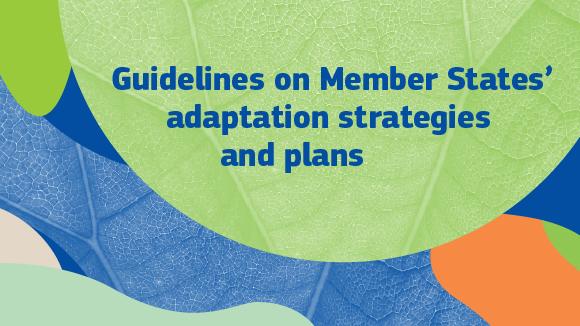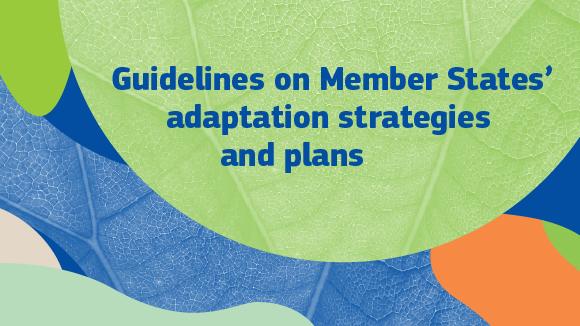
The European Commission today adopted a new set of guidelines to assist Member States in updating and implementing comprehensive national adaptation strategies, plans and policies in line with the European Climate Law and the EU Strategy on adaptation to climate change.
From extreme heatwaves and devastating droughts, to deadly forest fires and rising sea levels eroding coastlines, the impacts of unchecked climate change are well known and are already taking a heavy toll. Today’s guidelines aim to help Member States upgrade their preparations for the reality of these rapidly intensifying impacts.
The latest findings of the Intergovernmental Panel on Climate Change (IPCC) report have underlined the urgency to adapt to the impacts of climate change: “There is a rapidly closing window of opportunity to secure a liveable and sustainable future for all” and “accelerated implementation of adaptation actions in this decade would reduce projected losses and damages for humans and ecosystems, and deliver many co-benefits.”
Making climate adaptation a top political priority
The guidelines represent a powerful tool for national administrations to make climate adaptation a top political priority. The Commission seeks to support Member States to adopt a whole-government approach to climate adaptation policy-making by way of multilevel coordination and mainstreaming, both horizontally, between different departments and vertically, at all levels of sub-national authorities (including regions and local administrations). The guidelines also include a comprehensive list of key features of adaptation policy, which should be applied to the overall national adaptation policy framework. These key features include:
- a call for legal frameworks instead of soft policies;
- regularly updated adaptation strategies and plans;
- climate risk assessments, based on the results of regular stress testing of infrastructure and systems;
- involvement of all relevant stakeholders, including those particularly vulnerable to climate change as well as those who might be important agents of change in the planning and implementation of adaptation actions.
- involvement of all relevant sectors and all levels of public administration, endowed with sufficient personnel and financial resources;
- continuous monitoring and evaluation of all adaptation actions.
Enhancing Member States’ strategies and plans
To improve Member States’ adaptation strategies and plans, the guidelines put forward new topics and policy areas that need to be considered in policy-making to ensure better outcomes. For instance, nature-based solutions, compared to other measures, often represent efficient, cost-effective adaptation options that bring significant social, environmental and economic co-benefits. Just resilience includes reducing the unequal burden of climate risks and ensuring equity in the distribution of benefits of adaptation. As the Guidelines demonstrate, these considerations should run through the whole policy-making process. The guidelines also provide various examples of maladaptation (i.e., unintended negative consequences of adaptation efforts) to provide a further learning opportunity from the lessons drawn from different adaptation options.
Background
These guidelines represent one of the key outcomes of the 2021 EU Adaptation Strategy and contribute to the objectives of adopting a more systemic approach to adaptation and improving adaptation strategies and plans.
The guidelines build on previous guidance issued in 2013 on developing adaptation strategies. However, they reflect the significant changes in the policy landscape both at the EU and national level since then. At EU level, the adoption of the EU Adaptation Strategy and the European Climate Law, both in 2021, have brought about the most notable change. The European Climate Law requires Member States to ensure continuous progress in enhancing adaptive capacity, strengthening resilience and reducing vulnerability to climate change in accordance with Article 7 of the Paris Agreement. The binding law also contains provisions for Member States' adaptation strategies and plans. At national level, since all Member States already have an adaptation strategy and/or plan, the new guidelines aim to help Member States update and improve them.
European Commission Executive Vice-President for the European Green Deal, Frans Timmermans, said: “The weather events many Europeans are experiencing these days will become more extreme and more frequent if climate change continues unchecked. They are a painful reminder of the need to step up both mitigation and adaptation action. Building on the EU’s Adaptation Strategy, the guidelines we have issued today will help all EU countries, regions and local administrations plan effective adaptation measures to protect our citizens, businesses, cities and nature from the impact of climate change.”

Recent extreme events – forest fires, droughts, floods, and fatal heat waves – both across Europe and the world, have demonstrated that the consequences of climate change are hitting our societies harder and faster than science has projected. The increase in extreme weather events and natural disasters has a growing impact on the physical and mental health of people, on the rest of nature and on economic assets. These guidelines are a powerful tool for national administrations to make climate adaptation a top political priority.
For More Information
Mission Adaptation to Climate Change
EU Adaptation Strategy (press release)
Details
- Publication date
- 26 July 2023
- Author
- Directorate-General for Climate Action
